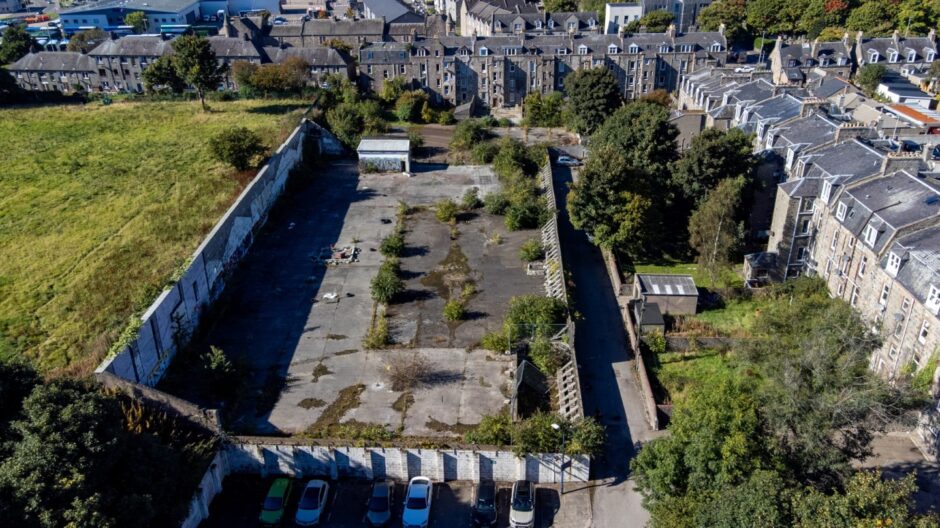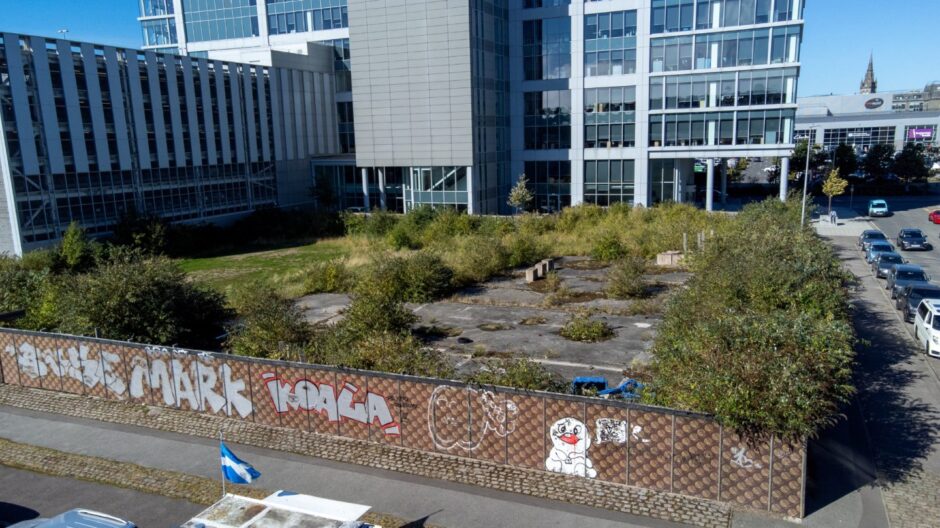
The area of Aberdeen covered by vacant and derelict land has more than doubled since 2016.
More than 100 hectares of the Granite City is listed as vacant or derelict in the latest Scottish Vacant and Derelict Land Survey (SVDLS).
The land is spread across 65 distinct sites – or 32 more recorded derelict or vacant spaces than in 2016.
With the number of sites steadily rising each year, we investigate if Aberdeen has a rising derelict and vacant land problem?
Our analysis reveals:
- The coverage of vacant land in Aberdeen has more than quadrupled, while derelict land and buildings fell slightly.
- The local authority owns just under a quarter of vacant and derelict sites.
- Just under half of the sites with known dates became derelict or vacant in the past four years.
How much of Aberdeen’s land is vacant or derelict?
The 101.35 hectares of derelict land is the equivalent to nearly 58 times the space covered by Marischal College.
Alternatively, that is equal to 154.4 Pittodrie-sized football fields…
There was a jump in the area after the pandemic when it leaped from 55ha to 94ha.
Vacant land covers sites which are no longer being used for their original purpose but it is ready for further development.
Derelict land, on the other hand, has been damaged by development. It is therefore incapable of development for beneficial use without rehabilitation.
Rising from 20 hectares in 2016 to 87, the coverage of vacant land has more than quadrupled.
The number of distinct vacant sites has tripled in that time from 16 to 50.
Meanwhile, the number of derelict sites has actually decreased from 17 in 2016 to 15.
Where is Aberdeen’s vacant and derelict land?
Dyce had the most derelict and vacant land and buildings in the latest survey.
A total of nine sites were located in the patch. It is followed by Kincorth, Leggart and Nigg with 7.
Use the map below to explore the exact locations of each of the sites listed on the derelict and vacant land and buildings register.
Torry and Bucksburn were joint third with six derelict or vacant sites each. However, in 2018 these two neighbourhoods had the most sites of any other Aberdeen area.
In 2018, the highest number of sites in a single official Aberdeen neighbourhood was four.
Meanwhile in 2016, no single neighbourhood had more than three sites within it.
Tillydrone was one of the areas with three derelict or vacant sites, yet it has none as of the latest survey.
The former life of the vacant and derelict land
Using previous reports from Aberdeen City Council we have also been able to analyse what type of sites have been left empty.
This information is not included in the summary statistics, so we gathered data form 2016 and 2018 to compare it to today’s picture.
Each year land previously used for education purposes such as schools accounted for the highest proportion of the vacant and derelict sites.
But new categories have risen to the top in 2023. Former offices now account for 15% of the vacant and derelict land.
The 10 former offices are compared with just one on the register in 2018 and none in 2016.
It soared above manufacturing which has in the previous two years taken second place.
2023 also saw more former agriculture sites and formerly residential sites.
These changes have led to education accounting for a smaller proportion of Aberdeen’s derelict and vacant land than in previous years.
A fifth of the 65 sites in 2023 were former education buildings and land. While in 2018 they accounted for nearly half (46.15%) of the year’s total.
Who owns Aberdeen’s vacant and derelict land?
Most of the vacant and derelict sites have private owners.
The local authority owns just under a quarter of vacant and derelict sites on the latest register (24.6%). But, just below half are listed as unknown private owners (49.2%).
The 32 sites with the owner type represents a five-fold increase from the six in 2018.
Meanwhile the number of sites owned by the local authority is the same as in 2018 but slightly higher than in 2016.
Two categories have remained the same since 2016. The former Cults Pumping Centre is owned by the Water Authority.
Meanwhile, the former Balgownie Centre is the only site with an owner in the “other non-crown” category.
Aberdeen City Council has been approached for comment.
The potential for a new lease of life
As part of the SVDLS, councils also provide data on the development potential of the sites.
More than half of the sites on Aberdeen’s most up to date register are developable in the medium term (56.9%).
Only 13 of the 65, or a fifth of the sites, are developable in the short term.
There is insufficient or uncertain information to ascertain the development potential of nine of the sites.
Compared to the previous years, 2016 and 2018, the medium-term projects are behind much of the increase in the number of vacant and derelict sites.
But what about the sites that have remained on the list since 2016? Has their development potential changed over the years?
There are 21 sites which have remained on the list from 2016, but few have seen their development potential shift.
Six of those sites were listed as short term in 2016 but half of those became medium term projects in 2018.
Three have been classified as being developable in the short term for seven years.
Those are the Former Ambassador Snooker Hall, St Peters Nursery School and the former Balgownie Centre.
A further four have remained unknown for more than seven years.
Of the 10 that were medium term in 2018 only one has been reclassified as short term in the five years to 2023.
The Press and Journal has investigated the plans for each of the 65 sites, as well as previous efforts to convert the abandoned land.
How long have they been derelict and vacant?
One site has been listed as derelict for more than 40 years. Rubislaw Quarry has been derelict since 1980, according to the official data.
Under a third, or 19 out of 65, of the sites do not have data on when it first became vacant or derelict
The remaining 46 have either a year or year range indicating when it became empty. Where a range was included, we dated it from the more recent year.
While some have been empty for decades, just under half of the sites with known dates became derelict in the past four years.
Since the pandemic in 2020, 22 sites have become derelict.
That is compared to 24 which have been empty for much longer without being removed from the list.

Conversation